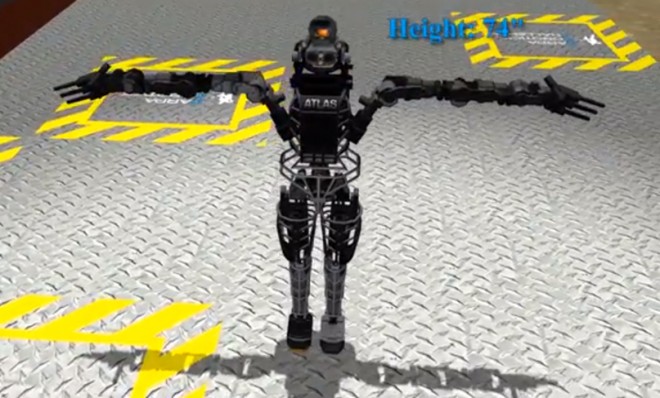DARPA's new humanoid robot is its most intimidating yet
Say hi to Atlas, a beefy machine in need of a brain

At 6'2" and 330 pounds, DARPA and Boston Dynamics' latest robot, Atlas, is arguably their most imposing humanoid yet. Like PetMan before it, the hydraulic-powered machine ambles along on two legs. But unlike its klutzy predecessor, Atlas possesses the sturdy resolve of a pro linebacker, and is apparently able to take a flying, 20-pound medicine ball right to the gut without tipping over.

The secret to Atlas' vastly improved strength and dexterity lies partly in its 28 hydraulic joints, which allow the machine to open doors, climb stairs, and jump across chasms. Crafted from aircraft-grade aluminum and titanium alloys, "Atlas can replicate almost every degree of human motion," notes Sebastian Anthony at ExtremeTech, "or, in the case of the robot hands provided by iRobot and Sandia National Labs, surpass them."
Yet though the machine comes equipped with laser and stereo vision systems, it is still eons away from T-800 territory, still requiring an electronic tether. Perhaps more importantly, it needs a software brain to breathe synthetic life into its intimidating physical capabilities.
The Week
Escape your echo chamber. Get the facts behind the news, plus analysis from multiple perspectives.

Sign up for The Week's Free Newsletters
From our morning news briefing to a weekly Good News Newsletter, get the best of The Week delivered directly to your inbox.
From our morning news briefing to a weekly Good News Newsletter, get the best of The Week delivered directly to your inbox.
That's why the Pentagon is holding a contest for more than a dozen teams to develop the software that will eventually power Atlas. Competitors from MIT, Virginia Tech, and more are currently designing computer programs that will ask the bot to enter and drive a vehicle, cross a rubble field, open doors, and use hand tools. The winning team will receive a prize of $2 million.
While Atlas' potential on the battlefield is hard to ignore, the basic idea is to develop a machine that can one day supplant the many dangerous tasks humans are asked to take on while putting their lives on the line.
"Two weeks ago 19 brave firefighters lost their lives," Gill Pratt, a program manager at the Defense Advanced Projects Agency, part of the Pentagon, tells the New York Times. "A number of us who are in the robotics field see these events in the news, and the thing that touches us very deeply is a single kind of feeling which is, can't we do better?"
Indeed, robotic firefighter heroes may one day be the norm. But in all likelihood, human-like robots like Atlas will be charged with life's more mundane roles as well, such as helping the elderly shop for groceries, or directing traffic at a busy intersection.
A free daily email with the biggest news stories of the day – and the best features from TheWeek.com
Which, come to think of it, is a preferable reality to a dystopian war zone, anyway.


